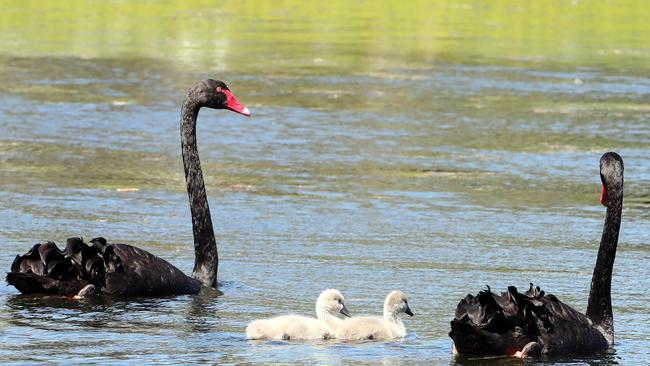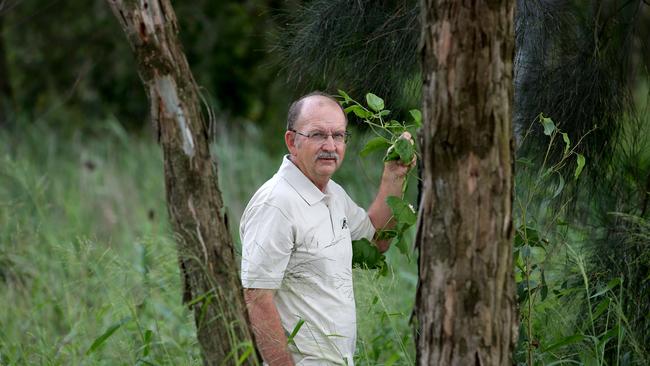Truth about Gold Coast’s Black Swan Lake shows it’s not toxic
INDEPENDENT scientific tests have revealed whether Black Swan Lake was toxic at the time councillors voted to fill it in. The results give a picture of the waterway’s health.

Pets & wildlife
Don't miss out on the headlines from Pets & wildlife. Followed categories will be added to My News.
BLACK Swan Lake is not toxic and proving to be an effective way to control pollution from the neighbouring horses stables, according to independent scientific tests.
The Gold Coast Bulletin can reveal councillors were provided with water sample analysis results taken in August 2016 and September last year which showed “most of the results have met the relevant water quality guidelines”.
BLACK SWAN LAKE: VULNERABLE JAPANESE SNIPE

But the findings were ignored as a majority of councillors voted to allow the Gold Coast Turf Club fill in the lake having read an earlier report by a spotter catcher about dead birds.
The scientific report funded by the Bulimba Creek Catchment Co-ordinating Committee on behalf of concerned Coast residents includes photographs showing stable wastes stored next to the Bundall lake.
Both the council and the State Government had failed to factor in or investigate the point-source for the pollution, the report said.
“The discharge is in contravention of water quality regulations and best practice stormwater management practices,” the report said.
WHAT COUNCILLORS WERE TOLD ABOUT BLACK SWAN LAKE
The lake was not only allowing Black Swans to roost and providing important habitat for flying foxes and microbars, it had protected the nearby Nerang River from potential stormwater nutrient inflows.

“The current results highlight the buffer service the lake provides, preventing this outflow that would otherwise enter the Nerang River and subsequently flow out to the ocean,” the report said.
Wayne Cameron said his 20-year-old group had funded independent professional water analysis by ALS Environment after the council accepted a spotter catcher’s report.
But a Tweed-based wildlife spotter findings for the Turf Club had convinced enough councillors that the lake was a toxic “borrow pit” which should be filled in for training amenities, an equine green space and overflow car parking.
Mr Cameron yesterday told the Gold Coast Bulletin: “The lake is not toxic and is improving, despite point source nutrients entering the lake.

“It would be very interesting for council and the community to finally know the truth about what was being done to understand the value of the lake.
“In my opinion, filling such an ecologically valuable natural asset is something done 60 years ago, not today because we now know enough to make the right decisions.
“It would be a soul-destroying assault on the community and set back conservation on the Gold Coast 20 years.”
The August 2016 scientific report said sampling in the previous two years showed “considerable algae presence” but the latest test found “the water clear with only minor algae flecks visible”.

The spotter-catcher report prepared for the Turf Club in June 2014 noted the bodies of six black ducks, a Dusky Moorhen, a Brahminy Kite, two flying foxes and the bones of other unidentified birds.
But catchment group’s scientific report noted: “This does not necessarily indicate toxins within the lake given the vast amount of birds which frequent the lake and show no symptoms of illness.
“Only autopsies and toxicology reports conducted by a suitably qualified person could determine the cause of death of the observed animals.”
Three months after the spotter-catching site visit, another check found only two dead ducks, a year later no dead birds had been spotted and only a single dead ibis was located in August 2016.

A further scientific report in September last year found the rehabilitation of the lake fringe with plants showed the work by the council was having a positive impact.
Photographs also showed that during a visit by residents that a “milky stream” was observed flowing into the lake.
Tests of that milky water proved it was 16 times the amount of total nitrogen stated in Queensland Water Quality Guidelines and 91 times the total phosphorous.
Each time an inspection of Black Swan Lake is conducted, there is always evidence of stable wastes adjacent to the edge of the lake,” the report said.
“The storm water entering the adjacent stables would be the most likely source given that urine, faeces and animal food from the horse stables contains large amounts of nitrogen and phosphorous that is interfering with the lake’s ability to regulate natural sources of nutrients.”
Mr Cameron told the Gold Coast Bulletin the councillors should have the strength to reverse their decision.
“We should stand back and say we were wrong with this and give it back to the community. I’m trying to back council out of a legacy that’s a black spot on their time in office,” he said.


